THE MINIMUM BATTERY:
WHAT EVERYONE SHOULD HAVE
WHAT EVERYONE SHOULD HAVE
 Everyone in this country who has not been convicted of a felony has a fundamental and irrevocable civil right to own weapons for any legal purpose. The existence and nature of this right is explicitly recognized in the Second Amendment in the Bill of Rights. The case of Heller vs.
Everyone in this country who has not been convicted of a felony has a fundamental and irrevocable civil right to own weapons for any legal purpose. The existence and nature of this right is explicitly recognized in the Second Amendment in the Bill of Rights. The case of Heller vs.
In the light of this clarification of what "the right of the people to keep and bear arms" means, it's necessary to address this question: assuming you choose to exercise your right, what sorts of arms do you need to "keep and bear"?
This discussion is intended for the never-owned-a-gun-in-my-life individual who has made the decision that, as a free citizen who wants to stay that way, it's time he or she were armed. What would I advise such a person to buy, as a "minimum arsenal" for all his potential needs?
WHY AMERICANS OWN GUNS
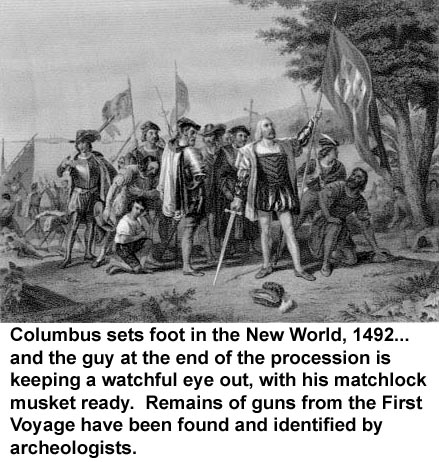 On the first day Europeans set foot in the New World in 1492, the men in
On the first day Europeans set foot in the New World in 1492, the men in  A much stronger case can be made for regulating sporting guns than weapons for military and quasi-military use, but it would be pointless: all sporting weapons are derived ultimately from military designs, and the line between them (if there is one) is blurry at best.
A much stronger case can be made for regulating sporting guns than weapons for military and quasi-military use, but it would be pointless: all sporting weapons are derived ultimately from military designs, and the line between them (if there is one) is blurry at best.
"Gun control" isn't about guns, it's about control, and who gets to exercise it. The Second Amendment is the "enforcement clause" of the Bill of Rights, the Founders' way of ensuring that people will always have the means to resist tyranny. That's the real reason we Americans own guns: to remain free. You may be able to convince armed citizens to do something they don't want to do, but you can't compel them.
SHOTGUNS
First of all, above all else, and if nothing else, get a shotgun.
 The shotgun is the most useful and adaptable of firearms, suitable for hunting, and for defense of the home, workplace, or even the nation[1]. About the only thing a shotgun isn't really suited for is concealed carry but even that can be done under the right circumstances, if need be. There should be a shotgun in every home in the country and everyone in that home old enough to do so safely should know where it is and how to use it.
The shotgun is the most useful and adaptable of firearms, suitable for hunting, and for defense of the home, workplace, or even the nation[1]. About the only thing a shotgun isn't really suited for is concealed carry but even that can be done under the right circumstances, if need be. There should be a shotgun in every home in the country and everyone in that home old enough to do so safely should know where it is and how to use it.
Any shotgun is better than no shotgun, but a quality pump-action or autoloading shotgun in 12 or 20 gauge is the best choice. Brand doesn't matter: any pump or autoloader now on the market is a good choice and excellent value for money. I am partial to the 12 because ammunition is available anywhere, but a 20 gauge is perfectly suitable. Stay away from 16's: ammunition can be hard to find.

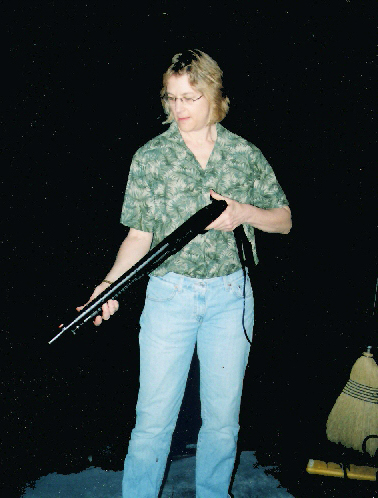 Short-barreled shotguns (minimum legal length is 18") are exceptionally effective: far more powerful than any handgun, as well as much easier to score a hit with. One with a pistol grip is harder to control but it's short enough to be used in an automobile (and even, if needed, to be hidden under a long coat). Additionally, shotguns often pass muster as legal in some restrictive jurisdictions where handguns are prohibited.
Short-barreled shotguns (minimum legal length is 18") are exceptionally effective: far more powerful than any handgun, as well as much easier to score a hit with. One with a pistol grip is harder to control but it's short enough to be used in an automobile (and even, if needed, to be hidden under a long coat). Additionally, shotguns often pass muster as legal in some restrictive jurisdictions where handguns are prohibited.
With respect to optional sporting use, a shotgun has no peer for utility. Just about anything that walks, crawls, or flies is taken with shotguns. In grizzly country shotguns are often carried by hikers and prospectors as protection against bear attacks. The .410 is far less useful than a 12 or 20 in any application. Unless you have a .410 already, pass it up.
"A NATION OF RIFLEMEN"
Now you need a rifle. Two rifles, actually: a .22 and something bigger.
 A .22 rifle is as basic a tool as a screwdriver or an electric drill, and no home should lack one. The .22 rifle isn't a great choice for personal defense—though it will do, if you know how to use it properly—but it's inexpensive and fun to shoot. It can also be used for small game hunting, of course.
A .22 rifle is as basic a tool as a screwdriver or an electric drill, and no home should lack one. The .22 rifle isn't a great choice for personal defense—though it will do, if you know how to use it properly—but it's inexpensive and fun to shoot. It can also be used for small game hunting, of course.
The best option is an autoloader. Good ones are cheaper than other action types in most cases. Stick with the .22 Long Rifle, forget about the .22 Magnum. Long Rifle ammunition is cheap enough to burn up in quantity, the .22 Magnum isn't. Again, any .22 rifle is better than no .22 rifle, and if you prefer a 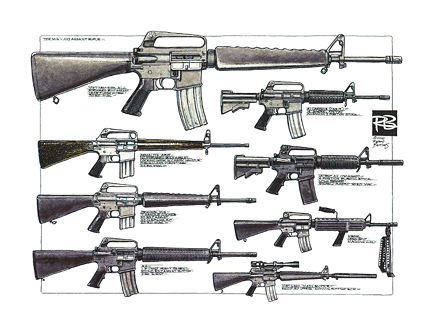 non-autoloader, go for it.
non-autoloader, go for it.
You should have a high-powered rifle. They're not really well suited to home protection because the bullets will penetrate walls and floors and ceilings, posing danger to people you can't even see. But if and when the excrement hits the ventilator, you will need one, badly. If you never plan to hunt, get an autoloading rifle in .223 Remington caliber: this is what the
If you buy a rifle for hunting, a medium-bore (i.e., larger than a .22 and smaller than a .45) in any action type you  prefer is fine. The specific caliber isn't all that important but should be powerful enough to handle anything you think you might hunt someday. In practical terms this means a .30-06, .308, or .270. The minimum I'd recommend for a general-purpose hunting rifle is the .30-30
prefer is fine. The specific caliber isn't all that important but should be powerful enough to handle anything you think you might hunt someday. In practical terms this means a .30-06, .308, or .270. The minimum I'd recommend for a general-purpose hunting rifle is the .30-30
HAND ME DOWN MY SHOOTING IRON
Now you need two handguns (that's a minimum, three would be better).
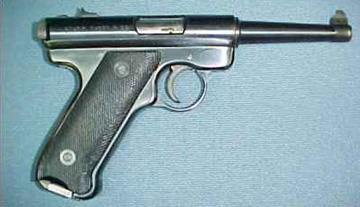 Buy a .22 caliber handgun to keep your hand and eye in practice. Autoloader or revolver, whatever you're comfortable with. A .22 isn't really a defensive weapon, but it can be comforting to have one along on a hike in the National Forest, where the predators tend to have two legs, not four. Whatever you choose should be lightweight, pleasant to shoot, and reasonably compact. Barrel length should be under 6" and a 4" barrel is much handier and more useful. Autoloaders, by virtue of their design, can have slightly longer barrels in the same overall length as a comparable revolver.
Buy a .22 caliber handgun to keep your hand and eye in practice. Autoloader or revolver, whatever you're comfortable with. A .22 isn't really a defensive weapon, but it can be comforting to have one along on a hike in the National Forest, where the predators tend to have two legs, not four. Whatever you choose should be lightweight, pleasant to shoot, and reasonably compact. Barrel length should be under 6" and a 4" barrel is much handier and more useful. Autoloaders, by virtue of their design, can have slightly longer barrels in the same overall length as a comparable revolver.
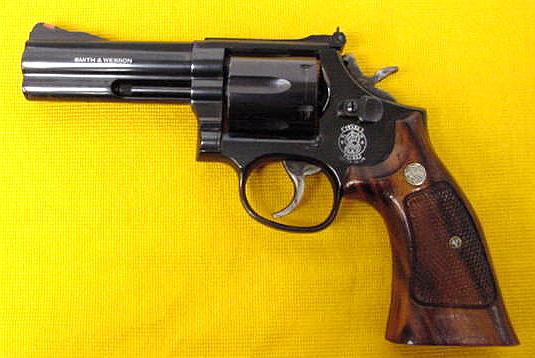 The other handgun you need is one to use a personal defense weapon. If you never carry a gun outside the house, size and weight are relatively unimportant. If you do, compact and lightweight are the criteria that are second only to effectiveness in making a decision.
The other handgun you need is one to use a personal defense weapon. If you never carry a gun outside the house, size and weight are relatively unimportant. If you do, compact and lightweight are the criteria that are second only to effectiveness in making a decision.
Guns for the house (and to some extent the car) should have 4"barrels and be chambered for .357 Magnum, 9mm Parabellum, or .45 ACP, all readily available and all with a proven record of effectiveness. The .357 can be used with .38 Special ammunition for inexpensive practice and lowered muzzle blast and recoil. Very short barreled revolvers in .357 Magnum can be painful to shoot and waste a lot of their power in making a stupendous noise and huge fireball.
If you do carry outside the home, 99.9% of the time the gun will be concealed. In 50+ years of carrying a gun on my person I've come to value concealability and weight above all other qualities, assuming the caliber is adequate. Nothing is entirely satisfactory, but you can work out a compromise between power and concealment that works for most situations.
Thanks to better ammunition choices viable choices for a concealed weapon include guns in .32 ACP and .380 ACP as well as those mentioned above. Additionally, the 9mm Parabellum (and to some extent the .40 S&W) are now available in very lightweight and easily concealed guns. I have yet to encounter a .45 of any kind that can be carried concealed comfortably for any length of time. I once had occasion to carry a Colt Combat Commander in.45 for a 12-hour stretch; when I took it off and relived myself of its 39 ounce weight I felt like I would float away.
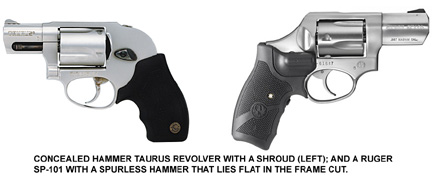
The orthodox choice for a carry gun is a 2" barreled .38 Special. All very well and good, but revolvers are harder to conceal than autoloaders of similar size. That said, a very light .38 Special with a spurless hammer (not a hammer shroud[2]) can be carried all day without discomfort in a pocket or belt slide holster, certainly makes a fine car gun, and can double as a house gun.
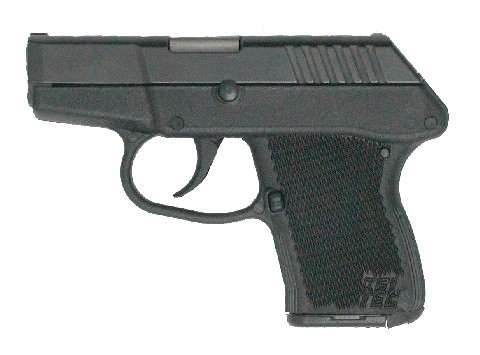 I'm going to put in a plug here for my day-to-day carry gun, a Kel-Tec P3AT autoloader in .380 ACP, loaded with premier expanding ammunition such as Remington's "Golden Saber." This gun will hide anywhere, including the pocket of a bathing suit. I carry it in a pocket holster designed for a .25 Auto, it's that small! The .380 with good ammunition is a serious threat and this little gun is almost in the same class as a .38 Special snubbie in terms of power. The wound it makes "...'tis not so deep as a well nor so wide as a church door, but 'tis enough, 'twill serve."
I'm going to put in a plug here for my day-to-day carry gun, a Kel-Tec P3AT autoloader in .380 ACP, loaded with premier expanding ammunition such as Remington's "Golden Saber." This gun will hide anywhere, including the pocket of a bathing suit. I carry it in a pocket holster designed for a .25 Auto, it's that small! The .380 with good ammunition is a serious threat and this little gun is almost in the same class as a .38 Special snubbie in terms of power. The wound it makes "...'tis not so deep as a well nor so wide as a church door, but 'tis enough, 'twill serve."
If you can wear what the NRA's Personal Protection Course calls a "concealment garment," a very light ("Airweight") revolver or autoloader in an effective caliber, carried in a minimalist belt slide holster, is as good as it gets. The 9mm Parabellum, .38 Special, .44 Special[3], and even the .45 ACP can be had in such guns. I gave up on inside-the-waistband holsters long ago: despite their excellent concealment I never found one that was comfortable, even with a small gun. Ditto a shoulder holster, which feels like a parachute harness. The problem with any gun so carried is that you can't take your jacket off in public.
FIRST RULE OF GUNFIGHTS: BRING A GUN
Any gun is better than no gun.
The ideal to which we aspire is a world in which no one fights, and the best way to avoid having to use the gun is to avoid situations where you might have to. But as the 4th Century Roman general Publius Flavius Vegetius Renatus said, "Igitur qui desiderat pacem, praeparet bellum." ("Let him who would have peace be prepared for war.")
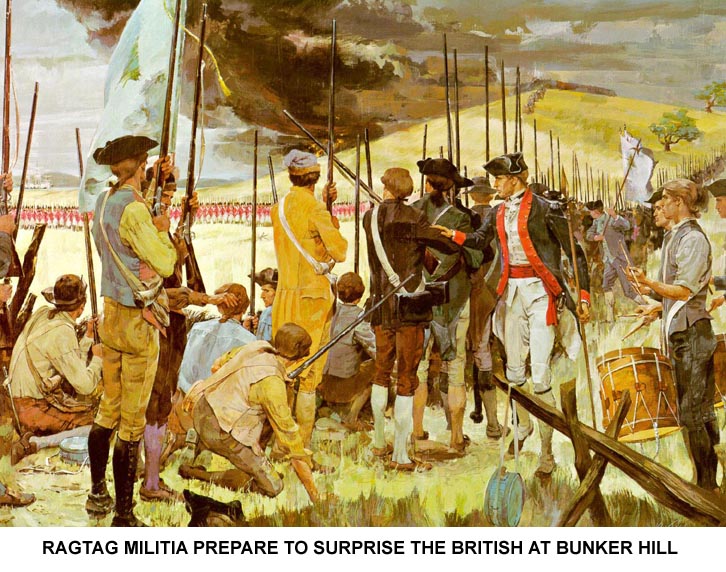
The Framers were men who'd personally experienced tyranny, and had fought against it actively. They were scholars and students of history, who understood the real meaning of Vegetius' maxim, with which they were fully conversant. They had no desire to fight, but they understood that in this imperfect world sometimes fighting can't be avoided, and he who fails to recognize this reality is a fool. Worse, he will become a slave.

That's why they wrote the Second Amendment: the will to resist compulsion (be it in the form of a nighttime intruder or a pack of jack-booted thugs) isn't enough. The means have to be there as well. English law and Roman principles—and their own experience—upheld the rights of all citizens to personal defense, and those citizens' duty to serve as part of the national defense in times of need. As the Court has now made clear even to the densest and most anti-gun member of Congress, the Second Amendment expressly states that the right exists; that it long pre-existed the formation of the nation; and it cannot be abridged or infringed. Modern day citizens, no less than those of the early Republic, not only have a right to "keep and bear arms," they have a positive duty to exercise it.